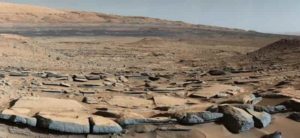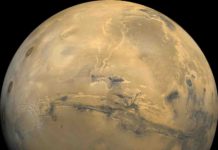
As the Mars InSight lander begins listening to the interior of Mars, some scientists are already proposing that some marsquakes could be signals of groundwater beneath the frozen surface of the Red Planet.
The idea, proposed by Michael Manga, a planetary scientist at the University of California at Berkeley, and his colleagues, is that Mars could be experiencing quakes a lot like those being felt in Oklahoma and Texas due to wastewater injections from fracking.
On Earth, water from fracking is injected deep into the ground where it increases the pressure in the pores—tiny spaces between the grains that make up the ground. That pressure can loosen up faults and cause them to slip and send vibrations—the shaking of an earthquake—far and wide.
On Mars, it might also be about the pore pressure, said Manga who is the lead author of a paper describing their hypothesis in the AGU journal Geophysical Research Letters. But instead of fracking, Manga proposes that the wintry temperatures of Mars’s surface might penetrate downward into liquid groundwater, freezing the top layers of groundwater and compressing the still-liquid groundwater below. That pressurized groundwater could be loosening faults on Mars and causing just the sorts of shallow marsquakes that have already been detected by the Insight lander, he said.
That’s not the entire story, however, because marsquakes need triggers. By modeling their hypothetical ice-squeezed aquifers, Manga and his colleagues found that the two likely triggers of marsquakes are the tidal tugs of Mars’s moon Phobos and the Sun, as well as barometric pressure changes. The last is caused by the warming and cooling of its thin atmosphere by the Sun.
If Manga and his colleagues are correct, Insight should start to detect a pattern to marsquakes which match changes in the tidals forces and the barometric pressure. If that happens it could be taken by some as evidence of deep, pressurized groundwater. If that water really exists, future Mars explorers might be able to drill down to it and the water would come shooting out of the ground under its own pressure, like an artesian spring, Manga said.
The hypothesis might also explain some of the features—like icy ridges and ice volcanoes—seen on icy moons in the solar system, he said.
And if the patterns of marquakes do not fit the pattern of pressurized groundwater? “Either way, the answer is fascinating,” said Manga.
Reference:
Michael Manga et al. Squeezing Marsquakes out of groundwater, Geophysical Research Letters (2019). DOI: 10.1029/2019GL082892
Note: The above post is reprinted from materials provided by American Geophysical Union.










